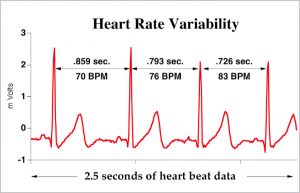Lower Heart Rate and Increase its Variability with Meditation
By John M. de Castro, Ph.D.
“If a person’s system is in more of a fight-or-flight mode, the variation between subsequent heartbeats is low. If one is in a more relaxed state, the variation between beats is high. In other words, the healthier the ANS the faster you are able to switch gears, showing more resilience and flexibility. Over the past few decades, research has shown a relationship between low HRV and worsening depression or anxiety. A low HRV is even associated with an increased risk of death and cardiovascular disease.” – Marcelo Campos
In our lives we are confronted with a variety of situations and environments. In order to successfully navigate these differing situations, we must be able to adapt and self-regulate. The Autonomic Nervous System (ANS) is designed to adapt physiologically to the varying demands on us. It is composed of 2 divisions; the sympathetic division underlies activation, including increases in heart rate and blood pressure, while the parasympathetic division underlies relaxation, including decreases in heart rate and blood pressure. A measure of the balance between these systems is provided by the variability of the heart rate.
Heart Rate Variability (HRV) refers to the change in the time intervals between consecutive heart beats. Higher levels of HRV are indicative of flexibility in the Autonomic Nervous System and are associated with adaptability to varying environments. Mindfulness has been associated with psychological flexibility and a greater ability to adapt appropriately to differing situations. It makes sense then to investigate the relationship of mindfulness to and Heart Rate Variability (HRV).
In today’s Research News article “Meditation Practice Improves Short-Term Changes in Heart Rate Variability.” (See summary below or view the full text of the study at: https://www.ncbi.nlm.nih.gov/pmc/articles/PMC7142551/), Chang and colleagues performed 2 experiments. In the first, they recruited healthy meditation naïve adults and presented them with a 90-minute class on meditation including practice in a face to face setting once a week for 4 weeks. In the second experiment experienced meditators were recruited and received once a week for 4 weeks the 90-minute class on meditation including practice presented on video. The participants wore wrist heart rate monitors and were measured over the course of the study for heart rate, heart rate variability, and blood pressure.
They found that both the meditation naïve participants with face to face instruction and the experienced meditators with video instruction had significant decreases over the course of the study in heart rate and significant increases in heart rate variability. Increased heart rate variability signals greater relaxation in the autonomic nervous system with a predominance of parasympathetic (relaxation) activity over sympathetic (activation) activity. The results make sense as parasympathetic activity tends to decrease heart rate. This all signals greater physiological relaxation
There was no control condition in the present study. So, the experiment is open to confounding by demand characteristics, experimenter bias, expectancy (placebo) effect etc. But prior randomized controlled studies have also observed that mindfulness training reduces heart rate and increases heart rate variability. So, the present results are likely due to the meditation practice. This increase in parasympathetic activity produced by meditation training may explain why mindfulness training is effective in treating cardiovascular diseases, in overall reducing the deleterious effects of stress and producing increased relaxation.
So, lower heart rate and increase its variability with meditation.
“meditation may improve your heart’s recovery from stress as demonstrated by improved Heart Rate Variability (HRV).” – Sam Sly
CMCS – Center for Mindfulness and Contemplative Studies
This and other Contemplative Studies posts are also available on Google+ https://plus.google.com/106784388191201299496/posts and on Twitter @MindfulResearch
Study Summary
Chang, K. M., Wu Chueh, M. T., & Lai, Y. J. (2020). Meditation Practice Improves Short-Term Changes in Heart Rate Variability. International journal of environmental research and public health, 17(6), 2128. https://doi.org/10.3390/ijerph17062128
Abstract
Background: It is well known that meditation improves the physical and psychological condition of its practitioners. This study investigated the heart rate variability response of meditation practitioners in two Chan master teaching environments, namely face-to-face and video classes. Methods: Experimental sessions were conducted, one featuring face-to-face classes and the other featuring video classes. The difference in participants’ physiological parameters (blood pressure and heart rate variability) between the two experimental sessions was determined. In the first session, physiological parameters were recorded twice, before and after one teaching course, and the second session took place one month after the first. The first and second sessions had 45 and 27 participants, respectively. Those involved in the first experiment had no experience with meditation, whereas participants in the second experiment had practiced meditation for an average of 9 years (range = 1 to 27 years). Both experiments were conducted once a week, with each session lasting 1.5 h. Results: For both experiments, both heart rate and heart rate variability by age significantly decreased after one teaching course. Conclusions: Chan meditation practitioners benefit from receiving both face-to-face and video class teaching from a Chan master.
https://www.ncbi.nlm.nih.gov/pmc/articles/PMC7142551/
